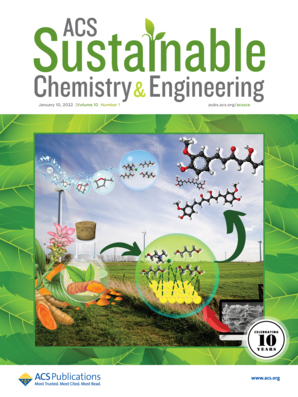甘蔗生物精炼厂3-羟基丙酸可持续生产菌株和生物工艺改进的环境和经济效益
IF 7.1
1区 化学
Q1 CHEMISTRY, MULTIDISCIPLINARY
引用次数: 0
摘要
生物基3-羟基丙酸(3-HP)是一种备受追捧的平台化学品,全球需求不断增长。微生物直接将糖转化为3马力是一种很有前途的替代化石燃料生产的方法,具有减少温室气体(GHG)排放的潜力。本研究考察了技术进步对3-HP产量、滴度和体积生产率的影响,重点关注了从甘蔗糖蜜中生产3-HP的生物精炼厂的最低销售价格(MSP)和生命周期温室气体排放。在Aspen Plus中模拟了利用通量平衡分析(FBA)生成的代表替代和理论生物工艺性能的完整范围的生物炼制场景。FBA结果表明,丙二酰辅酶a、β-丙氨酸和草酰乙酸途径在酿酒酵母胞质中生产3-HP的理论产量(0.801 ~ 0.824 g3-HP·g - 1葡萄糖)相似,而草酰乙酸途径在酵母胞质中生产3-HP的最大产量高出16 ~ 21%。酿酒酵母线粒体定位丙二酰辅酶a途径的产率最高(0.853 g3-HP·g-1glucose),而德巴斯德酵母的产率仅略有提高。利用谷氨酸棒状杆菌生产3-HP在经济上是可行的,MSP比目前化石燃料的市场价格低33.8%。与基线相比,完全优化的生物过程将使MSP减少相似的量,温室气体排放量减少43.0%。本文章由计算机程序翻译,如有差异,请以英文原文为准。

Environmental and Economic Benefits from Strain and Bioprocess Improvements for Sustainable Production of 3-Hydroxypropanoic Acid in a Sugarcane Biorefinery
Biobased 3-hydroxypropanoic acid (3-HP) is a highly sought-after platform chemical with growing global demand. Direct microbial conversion of sugars to 3-HP is a promising alternative to fossil fuel-based production, with the potential to reduce greenhouse gas (GHG) emissions. This study examines the impacts of technological advancements in 3-HP yield, titer, and volumetric productivity, focusing on the minimum selling price (MSP) and life cycle GHG emissions for biorefineries producing 3-HP from sugarcane A-molasses. Biorefinery scenarios representing the complete range of alternative and theoretical bioprocess performances, generated using flux balance analysis (FBA), were simulated in Aspen Plus. FBA showed that theoretical yields from cytosolic 3-HP production in Saccharomyces cerevisiae were similar for the malonyl-CoA, β-alanine, and oxaloacetate pathways (0.801–0.824 g3-HP·g–1glucose), whereas the maximum yield from the oxaloacetate pathway in the cytosol of Komagataella pastoris was 16–21% higher. Mitochondrial localization of the malonyl-CoA pathway in S. cerevisiae led to the highest yield (0.853 g3-HP·g–1glucose), while only slight improvements were seen in K. pastoris. 3-HP production by Corynebacterium glutamicum was economically viable, with an MSP 33.8% below the current fossil-based market price. Fully optimized bioprocesses would reduce the MSP by a similar amount and lower GHG emissions by 43.0% compared with the baseline.
求助全文
通过发布文献求助,成功后即可免费获取论文全文。
去求助
来源期刊

ACS Sustainable Chemistry & Engineering
CHEMISTRY, MULTIDISCIPLINARY-ENGINEERING, CHEMICAL
CiteScore
13.80
自引率
4.80%
发文量
1470
审稿时长
1.7 months
期刊介绍:
ACS Sustainable Chemistry & Engineering is a prestigious weekly peer-reviewed scientific journal published by the American Chemical Society. Dedicated to advancing the principles of green chemistry and green engineering, it covers a wide array of research topics including green chemistry, green engineering, biomass, alternative energy, and life cycle assessment.
The journal welcomes submissions in various formats, including Letters, Articles, Features, and Perspectives (Reviews), that address the challenges of sustainability in the chemical enterprise and contribute to the advancement of sustainable practices. Join us in shaping the future of sustainable chemistry and engineering.
 求助内容:
求助内容: 应助结果提醒方式:
应助结果提醒方式:


